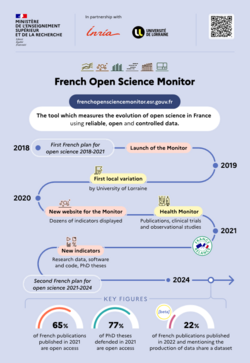The French Open Science Monitor
70.3 % of University of Lille scientific publications from 2023 are in open access, compared with 65.7 % nationally*.
What is the French Open Science Monitor?
The French Open Science Monitor, created in 2019 by the French Ministry of Higher Education and Research, is part of the National Plan for Open Science and aims to measure the development of open access (access without technical or financial barriers) to French scientific publications. Generalising open access to publications is a key part of the open science strategy at both the national and local levels.
The Open Science Monitor of the University of Lille was produced by the University libraries using the source code and methodology developed by the University of Lorraine, enabling institutions to adapt the national monitor. The Open Science Monitor offers a wide range of indicators for several of the actions defined in the University of Lille's Roadmap for open science and is therefore a steering tool in the University of Lille's open science strategy.
How is the Open Science Monitor of the University of Lille constructed?
The Open Science Monitor of the University of Lille is built according to the methodology presented above. It is based on the compilation, from different sources, of the list of scientific publications produced each year by researchers and research support staff at the University of Lille (publications where at least one author is affiliated with the University of Lille). The sources used are Web of Science™, PubMed® and the open archives LillOA and HAL. The publications taken into consideration are articles and preprints, books and parts of books, and papers from conference proceedings, published between 2016 and 2022. The open access status of publications with a DOI is provided by the Unpaywall tool, which classifies them into four categories of openness: open access via the publisher, via an open archive, or via the publisher and the open archive; or closed access.
Here, only publications with a DOI are taken into account. The use of databases and the restriction to publications with a DOI to identify the open access status via Unpaywall exclude some scientific output, particularly in the Humanities and Social Sciences. The list of publications is therefore not exhaustive. However, these biases are common to both the national Open Science Monitor and its local versions, which means that comparisons can be made.
A few indicators
All the indicators and graphs are available on the French Open Science Monitor page via the university's identifier: 130029754.
* Data collected on 10 September 2025. The graphs are updated automatically and may therefore differ slightly.
Methods of providing open access to publications*
The graph below illustrates how, in 2024, the University of Lille's publications that have a Crossref DOI, were distributed in terms of open access by year of publication and by method of providing open access. For example, for publications published in 2023, 70.3% are open access, including 44% via the publisher and an open archive, 16% via an open archive only and 10% via the publisher only.
Generally speaking, the rate of open access has been increasing since 2016, with publications being opened up both by the publisher and with open archives.
Open access by discipline*
Depending on the discipline, we can observe specificities in terms of the open access method used.
For each discipline, the graph below shows the respective shares of the various open access methods for University of Lille publications with a Crossref DOI that were published in 2023 and observed in 2024. We can observe, for publications in fundamental biology for example, that 6% are in open access via the publisher, 10% are in open access via deposit in one or more open archives, and 57% are in open access via these two methods simultaneously.
For some disciplines, open access to publications is provided predominantly by open archives, as is the case for computer science and information science (47%) and mathematics (44%).
The humanities and social sciences (open access rates of 60% and 55% respectively) appear to be on the sidelines of the overall trend towards openness, but as a reminder, publications in these disciplines are under-represented in the collection of publications that is being analysed, especially since only publications with a Crossref DOI are considered here.
Focus on open archives*
The graph below focuses on open archives and in particular shows the rates of coverage of the various open archives used to provide open access to the University of Lille's publications. It should be noted that these publications may simultaneously be made available in open access by the publisher.
For example, in 2024, 54% of publications from 2023 were in open access in an open archive, including 38% in HAL.
Overall, in 5 years coverage by open archives has doubled, from 26% to 54%.


